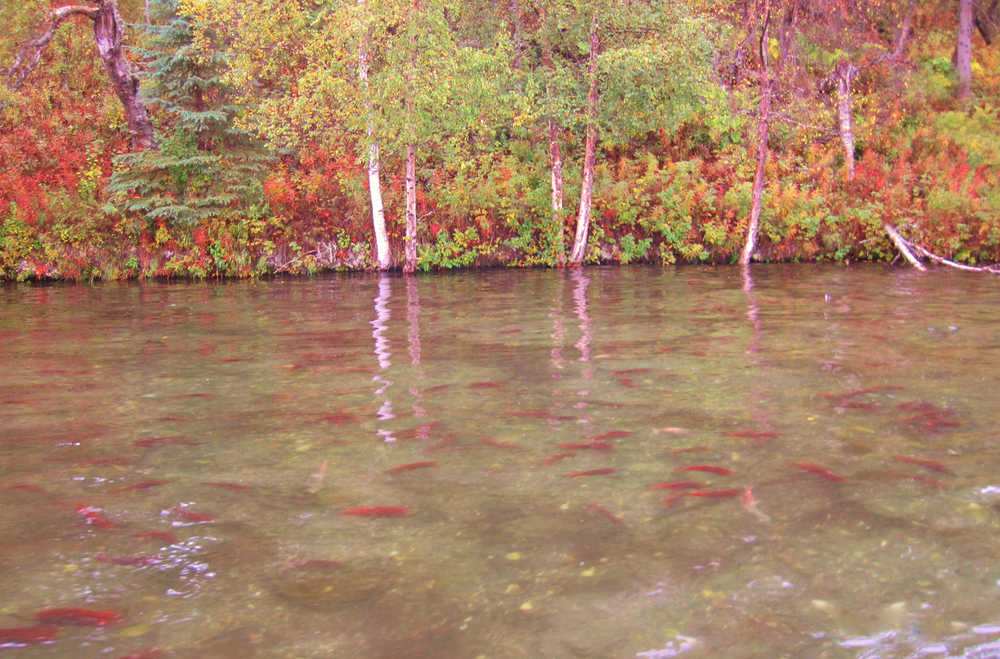The good news is that Elodea, the first submerged freshwater invasive plant to make it to Alaska, may be gone from the Kenai Peninsula. Last week, Kenai National Wildlife Refuge biologists re-surveyed 50 sites in each of the three lakes on the Kenai Peninsula in which Elodea is (or was) known to occur. When these lakes north of Nikiski were first surveyed in May 2014, just prior to herbicide treatments, Elodea was present on 70 percent of Beck Lake sites, 50 percent of Stormy Lake sites, and 22 percent of Daniels Lake sites. Now, two years later, we can find no trace of Elodea on these 150 sites or any other places we have sampled with throw rakes.
Elodea really is one of the nastier invasives, able to grow so abundantly under the right conditions that it can alter water chemistry, degrade spawning habitat, hinder boat and float-plane traffic, and reduce property values. And it spreads so easily! Because it can reproduce asexually, a single fragment from an aquarium dump or carried by a floatplane can be the start of a new infestation.
Success to date is partially the result of a highly collaborative effort to eradicate Elodea that involved the U.S. Fish and Wildlife Service, Alaska Department of Natural Resources, Homer Soil & Water Conservation District, Kenai Peninsula Borough, Kenai Watershed Forum, University of Alaska Fairbanks Cooperative Extension Service, Cook Inlet Aquaculture Association, Alaska Department of Fish & Game, and some helpful residents from Beck and Daniels Lakes. We received great technical input from Dr. Lars Anderson, an invasive aquatic plant expert from the University of California-Davis, folks from SePRO Corporation, the manufacturer of fluridone (the herbicide we used), and Dr. Don Les from the University of Connecticut-Storrs who identified our uninvited pest as a hybrid.
Our success is also partially due to Elodea’s unusual reproductive biology. While Elodea can reproduce asexually from a single plant fragment, Elodea is also dioecious, meaning that the male and female parts are on different plants, so both sexes need to be present to produce seeds. Elodea on the Kenai fortuitously appears to have originated from a single-sex population so we don’t have to deal with a seed bank that can persist for years at the bottom of our lakes.
Nonetheless, we are far from being done with Elodea on the Kenai Peninsula. We will continue monitoring aquatic plant populations in these three lakes over the next two or three years, ensuring that Elodea really is eradicated and that native flora recover. We remain suspicious that Elodea might be in Bishop Creek, into which Beck and Daniels Lakes drain, but Elodea has yet to be detected there despite multiple canoe trips.
We will also continue to monitor fluridone concentrations in both water and sediment in the three lakes. Fluridone initially degrades by solar UV radiation and ultimately by temperature-dependent microbial action once bound in the sediment. As other infested areas in Alaska are now being treated with fluridone, the persistence of fluridone in our cold environment is a question being asked by others that we hope to address.
We think Elodea was introduced initially to Beck Lake by aquariums dumped from a small freshwater and tropical fish shop near the corner of Halibouty and Dragon Fly Roads that went out of business in the 1990s. Elodea probably barely survived the early years as the two parental species of our hybrid are native to much warmer and more nutrient-rich waters in the Midwest. Eventually, however, it adapted to the Kenai Lowlands and then began to grow quickly.
This scenario is plausible because when we sent live specimens from our lakes down to Fort Collins where Dr. Andrew Skibo from SePRO planned to test fluridone’s lethality, he couldn’t get this supposedly invasive hybrid to grow in the warm waters of the laboratory environment! When a second batch we sent him wouldn’t grow, Andrew had the bright idea of dropping the temperature in the growth chambers and that was all it took for the plant fragments to begin rapid cloning. This adaptation to colder waters has likely occurred independently in Elodea populations introduced from aquarium dumps into waters around Cordova, Fairbanks and Anchorage.
With the Alaska Division of Agriculture’s quarantine on importing Elodea in 2014, the aquarium trade is not likely to be the primary vector for future spread of Elodea. However, now that there are established populations elsewhere in Alaska, our biggest concern is that Elodea will be (or already has been) reintroduced to the Kenai Peninsula by a float-plane from Anchorage or Cordova. And with these populations already being cold-adapted, Elodea will fare well in whatever new waterbodies they end up in.
So even with our good news, comes the bad news that we need to remain vigilant. An easy way to report suspected Elodea is to take a close-up photo with your phone camera and email it to me at john_m_morton@fws.gov. With over 4,000 lakes on the peninsula, all eyes are needed!
Dr. John Morton is the supervisory biologist at Kenai National Wildlife Refuge. Find more information at http://www.fws.gov/refuge/kenai/ or http://www.facebook.com/kenainationalwildliferefuge.

